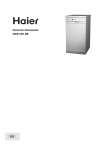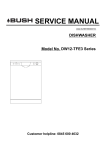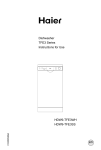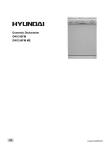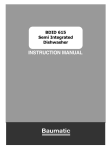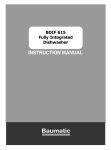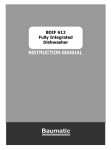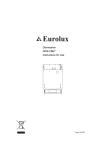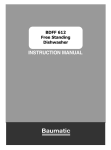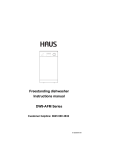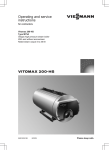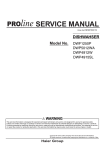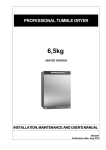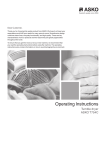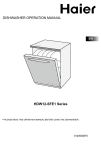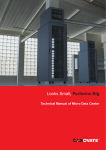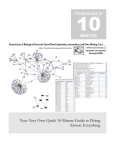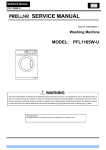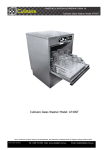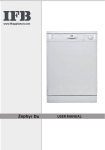Download Freestanding dishwasher Instructions manual DW12
Transcript
Freestanding dishwasher Instructions manual DW12-TFE3 Series Customer helpline: 0845 600 4632 0120505833D 27 Index Safety information 2 Installation 4 Electrical Connection 6 Getting to know your appliance 7 How to fill the salt container 8 How to fill rinse aid container 9 How to fill the detergent dispenser 9 Not suitable for the dishwasher 10 Dishes arrangement in dishwasher 11 Programme overview 13 Washing dishes 15 How to keep your dishwasher in shape 18 Care and maintenance 19 Trouble Shooting 21 Technical data 25 Important information 25 Disposal information 26 Product guarantee 27 Information on conformity tests implemented in compliance with EN 50242 Appliance loaded in accordance with standard specifications. Example of loaded dishwasher: See Fig 1 and 2 Capacity: 12 place settings Programme: Light Wash Rinse-aid setting: 5 Detergent: 5g+25g Fig.1 Fig.2 Height-adjustable top-basket must be inserted in the uppermost position. Disposal information The symbol on the product or on its packaging indicates that this product may not be treated as household waste. Instead it should be handed over to the applicable collection point for the recycling of electrical and electronic equipment. By ensuring this product is disposed of correctly, you will help prevent potential negative consequences for the environment and human health, which could otherwise be caused by inappropriate waste handling of this product. For more detailed information about recycling of this product, please contact your local council, your household waste disposal service or the shop where you purchased the product. 1 BUSH Dishwasher User Manual Customer Helpline 0845 600 4632 BUSH Dishwasher User Manual Customer Helpline 0845 600 4632 26 Technical data Safety information At time of delivery Width 60 cm Depth 60 cm Check packaging and dishwasher immediately for signs of transport damage. If the appliance is damaged, do not use it and contact the retailer or our approved customer service department without Height 85 cm delay. Please dispose of packaging materials properly. Capacity 12 standard place settings Mains water pressure 0.03-0.6MPa Power voltage 220-240V~ 50Hz Maximum current intensity 10A 1950W Total power During installation Site the dishwasher and connect it up in accordance with the installation instructions. The dishwasher must not be connected to the electricity supply while installation is being carried out. Ensure that the domestic wiring is properly earthed. The mains electricity supply must conform to the details shown on the dishwasher rating plate. Do not connect the dishwasher to the electricity supply using an extension cable. After the appliance has been installed, the mains plug should still be easily accessible. During installation, the power cable must not be excessively or dangerously kinked or flattened. This appliance cannot be installed outdoors, even if the area in which it is installed is covered by a Important information roof. It is very dangerous to leave the appliance exposed to rain and the elements. Notes on waste disposal Old appliances still have some residual value. An environment-friendly method of disposal will ensure that valuable raw materials can be recovered and used again. When an appliance has reached the end of its working life, unplug it from the mains. Cut through the mains cable and dispose of it together with the plug. Destroy the door locking mechanism. This will ensure that children cannot be locked inside and are not exposed to the risk of suffocation. Your new appliance was protected by suitable packaging. Please dispose of all packaging materials properly and ensure that they are kept out of children’s reach. Do not allow children to play with any parts of the packaging. There is a risk of suffocation from the cardboard boxes and the plastic wrapping. Up-to -date information concerning options for disposal can be obtained from your retailer or local council. General information Measures must be taken to ensure that built-under and built-in units that are later used as freestanding appliances cannot topple over. This can be achieved by bolting the dishwasher to the wall or fitting it under a continuous work surface which is screwed to the adjacent cupboards. 25 BUSH Dishwasher User Manual Customer Helpline 0845 600 4632 During normal use The dishwasher must only be used by adults for the washing of household dishes and cooking utensils. Do not place any heavy objects on the door or stand on the door when it is open. The appliance could tip forward. The water inside the dishwasher is not suitable for drinking. Do not use solvents of any kind inside your dishwasher. There is a risk of explosion. Open the door carefully if the dishwasher is operating. There is a risk of water coming out. Do not touch the heating element during or after a wash cycle. Fundamental rules to follow when using the appliance: - Never touch the dishwasher when barefoot or with wet hands or feet. - Do not use extension cords and multiple sockets. - If the appliance is not operating properly or maintenance must be performed, disconnect the appli ance from the power supply. BUSH Dishwasher User Manual Customer Helpline 0845 600 4632 2 If your family includes children or the infirm The appliance is not intended for use by young children or infirm persons without supervision. Young children should be supervised to ensure that they do not play with the appliance. Keep detergents out of the reach of children. Plastic items are discoloured Not enough detergent was added to dispenser. Detergent has insufficient bleaching properties. Use a detergent containing a chemical bleaching agent. White stains are left on crockery, glasses have a milky appearance Not enough detergent was added to dispenser compartment. Amount of rinse-aid was set too low. No salt has been put in appliance (if in a hard water area). If a fault occurs If the appliance malfunctions, turn off the water supply to the appliance, switch it off and disconnect the plug from the wall socket. Then, consult the section entitled "Trouble shooting". If you cannot solve the problem, contact a service centre. Only specialised personnel are authorised to make repairs. If the power cable is damaged, it must be replaced by the manufacturer or a manufacturer-approved service engineer. To maintain the EFFICIENCY and SAFETY of this appliance, we recommend: - Call only the service centres authorised by the manufacturer, or the approved service agents. - Always use original spare parts. Water softener was set too low. Salt container lid is not screwed tight. If you used a phosphate-free detergent, try a detergent containing phosphates and compare results. Dishes, cutlery, etc. have not been dried Selected programme did not include drying function. Amount of rinse-aid was set too low. Items were removed from dishwasher too soon. Glasses have a dull appearance Amount of rinse-aid was set too low. When disposing of old appliances Appliances which are no longer being used must be made inoperable by disconnecting the plug from the wall socket, cutting the power cable and removing the door lock. Take the appliance to a designated waste disposal centre. Tea stains or traces of lipstick have not been completely removed. Detergent does not have a sufficient bleaching effect. Washing temperature was set too low. Traces of rust on cutlery Cutlery is not sufficiently rustproof. Dangerous voltage Salt content in wash water is too high. - Salt container lid is not screwed tight. - Too much salt was spilt while filling container. Glasses become clouded and discoloured; coating cannot be wiped off Warning Children could get locked or stuck in the appliance (risk of suffocation). Therefore: Remove the mains plug and cut the mains wire. Damage the door lock so that the door can no longer be closed. Unsuitable detergent was used. Glasses are not dishwasher-proof. Smears left behind on glasses and cutlery; glasses have acquired a metallic appearance Amount of rinse-aid set too high. 3 BUSH Dishwasher User Manual Customer Helpline 0845 600 4632 BUSH Dishwasher User Manual Customer Helpline 0845 600 4632 24 Installation Water remains inside appliance after programme has ended. Positioning the appliance Positioning the appliance in the desired location. The appliance is equipped with water supply and drain hoses that can be positioned to the right or the left of the appliance to facilitate proper installation. Blockage or kink in drainage hose. Pump is jammed. Filters are blocked. The programme is still running. Wait for the programme to end. Levelling the appliance ...during washing Once the appliance is positioned, adjust the feet (screwing them in or out) to level the appliance. If the appliance is level, it will help to ensure proper performance. Unusual amount of foam is created Normal washing up liquid has been poured into the rinse-aid container. Remove any spilled rinse aid with a cloth as it could otherwise lead to excessive foaming during the next washing cycle. Appliance stops suddenly while washing is taking place Electricity supply has been cut off to appliance. Water supply has been interrupted. Knocking sound can be heard while washing is taking place A spray arm is knocking against the dishes inside the appliance. Rattling sound can be heard while washing is taking place Cold water connection Connect the water supply hose to a threaded 3/4 inch (ca. 19mm) connector, making sure that it is fastened tightly in place (see Fig. A). If the water pipes are new or have not been used for an extended period of time, let the water run for a while until the water is clear and free of impurities. If this precaution is not taken, there is a risk that the water inlet fig.A can get blocked and damage the appliance. Crockery has not been stacked properly inside the appliance. Knocking sound coming from inlet valves This is caused by the way the water pipes have been laid and it has no effect upon the way the appliance functions. There is no remedy for this. Warning The appliance is to be connected to the mains water using new hose sets. Old hose sets should not be reused. ...with the dishes,cutlery, etc. Food residue is stuck to the dishes, cutlery, etc. Dishwasher was not loaded properly. Jets of water could not reach all parts of the dishes, etc. Too many items in the rack. Items in the rack were touching each other. Not enough detergent was added to dispenser. 23 fig.B Anti-Flooding protection The dishwasher is equipped with a system that stops the supply of water in the event of a problem with the water supply hose or leaks within the unit, in order to prevent damage to your home. If for any reason Selected wash programme was not intensive enough. Rotation of spray arm was obstructed by dishes, etc. Nozzles in spray arm are blocked by food residue. Filters are blocked. the box containing the electrical components happens to get damaged, turn off the power supply and unplug the appliance immediately. In order to guarantee that the anti-flooding feature operates properly, box "A" with the water supply hose must be attached to the water supply tap as shown in Fig. B. If the length of the hose is not adequate to make a proper connection, the hose must be replaced with one Filters have been incorrectly fitted. Waste-water pump is jammed. which is long enough. This hose is available upon request from specialised retailers and approved service centres. BUSH Dishwasher User Manual Customer Helpline 0845 600 4632 BUSH Dishwasher User Manual Customer Helpline 0845 600 4632 4 Drain hose connection Insert the drain hose into a drain pipe with a minimum diameter of 4cm, making sure to avoid kinking or pinching. If necessary, fit a syphon trap (U-bend) with a connecting piece for the drain hose (Fig. C). The free end of the hose must be at a height between 40 and 100 cm and must not be immersed in water. When the buzzer emits 10 short warning signals every 30 seconds and the time-remaining indicator displays"E4" Have you checked whether: The drain hose is creased or kinked. The drain hose is too high. When the buzzer emits 10 short warning signals every 30 seconds and the time-remaining indicator displays"E5" Have you checked whether: The filter for the water supply hose is clogged. The drain hose is too low. MAX 100 cm MIN 40 cm The water is turned on and the hose is connected properly. The water supply to the house is on and has sufficient pressure. The water supply hose is creased or kinked. When the buzzer emits 10 short warning signals every 30 seconds and the time remaining indicator displays"E2" or "E6" contact the nearest authorised service centre. fig.C Attention: The syphon trap (U-bend) must be fastened to the wall to prevent the drain hose from moving and allowing water to spill. If you carry out all these checks and the appliance still does not function or your appliance has any other error display, power the appliance off and wait a few minutes. Then power the dishwasher on and try again. If the dishwasher still does not function and/or the problem persists, contact the nearest authorised service centre and provide them with the following information: The nature of the problem. The model type number (Mod...) and the serial number (S/N...), which is shown on the plate on the inner part of the door. Electrical Connection After making sure that the voltage and frequency values for your domestic electricity supply correspond to those on the rating plate (located on the inner door of the appliance), insert the plug into an electrical socket which is properly earthed (the earthing of the appliance is a legal safety requirement). Lower spray arm rotates with difficulty. Spray arm is blocked by small items or food residue. Detergent compartment lid cannot be closed Detergent compartment has been overfilled. Caution: Mechanism is clogged with remnants of detergent. The dishwasher's mains plug must be accessible even when the appliance is installed as a built-in unit so that maintenance can be carried out safely. 5 BUSH Dishwasher User Manual Customer Helpline 0845 600 4632 Remnants of detergent stuck inside dispenser. Compartment was damp when it was filled up with detergent. Compartment must be dry before detergent is added. BUSH Dishwasher User Manual Customer Helpline 0845 600 4632 22 Trouble Shooting Electrical Connection Resolving minor problems yourself Experience has shown that you can resolve most problems that arise during normal use. Not only does this save costs, but it also means that the appliance is available for use again that much sooner. The following list of common occurrences and their remedies should help you resolve most problems. ...when the appliance is switched on Appliance does not start up Fault with fuse in mains electricity supply. Plug not inserted in wall socket. Appliance door not closed properly. Programme button has not been pressed. Water tap not turned on. Blocked filter in water intake hose. - The filter is situated in the supply-hose connection. Caution Do not forget that repairs should only be carried out by a qualified specialist. Improper repairs can lead to considerable equipment damage as well as danger to the user. ...with the appliance itself Error display on the time-remaining indicator When the buzzer emits 10 short warning signals every 30 seconds and the time-remaining indicator displays"E1" Have you checked whether: The door is closed properly. When the buzzer emits 10 short warning signals every 30 seconds and the time-remaining indicator displays"E3" Have you checked whether: The drain hose is too low. 21 BUSH Dishwasher User Manual Customer Helpline 0845 600 4632 6 Getting to know your appliance Spray arms Close-up view (control panel) Lime scale and food residue can block the nozzles in the spray arms "10" and the arm mountings ”11”. A C E B A B C D E D F H J G I F G H I J State Indicator ON-OFF Button "3 in 1" Indicator "3 in 1" Button Delayed Start Indicator Delayed Start Button Inspect the nozzles in the spray arms for holes blocked due to food residue. If necessary, pull the lower arm "11" upwards and lift it off. Unscrew the upper spray arm "10". Low Salt Indicator Clean both spray arms under running water. Refit the spray arms. Ensure that the lower arm has locked into place and the upper one is screwed in tight. Ensure that the power supply is turned off prior to removal Programme selection dial. and cleaning of any internal parts. Time-remaining Indicator Low Rinse Aid Indicator 10 11 Dishwasher interior a i c b j e f g d k h a Upper Rack b Lower Rack g Washing Filter h Detergent and Rinse Aid Dispenser c Top Spray Arm d Silverware Basket i e Bottom Spray Arm f Salt Container Cap 7 BUSH Dishwasher Water Inlet Hose j Drain Hose k Power Supply Cord User Manual Customer Helpline 0845 600 4632 BUSH Dishwasher User Manual Customer Helpline 0845 600 4632 20 Care and maintenance How to fill the salt container Regular inspection and maintenance of your appliance helps to prevent problems from occurring. This saves time and aggravation. You should therefore carefully inspect the inside of your dishwasher from time to time. Overall condition of appliance Salt The hardness of water varies from place to place. If hard water is used in the appliance, deposits will form on the dishes and utensils. The appliance is equipped with a special softener that uses a salt specifically designed to eliminate lime and minerals from the water. Filling the container with salt Check that no grease or scale has accumulated on the inside of the dishwasher. If you discover any deposits, clean the interior of the dishwasher thoroughly with a dishwasher deter- Always use salt intended for use with dishwashers. The salt container is located beneath the lower rack and should be filled as follows: When the low salt indicator "1" lights, you must add salt. Remove the lower rack and then unscrew and remove the cap from the gent solution. salt container. If you are filling the container for the first time, fill it with water. Place the end of the funnel (supplied) into the hole and introduce about H Dishwasher salt Check the LOW salt indicator "I". Top up with salt, if required. 2 kg of salt. It is normal for a small amount of water to come out of the salt container. Carefully screw the cap back on. Rinse-aid I 1 Important Check the LOW RINSE AID indicator "H", on the front panel. Top up with rinse-aid, if required. To prevent the formation of rust, fill with salt just before beginning a wash cycle. Adjusting salt consumption Filters You can adjust the amount of salt used to suit the hardness of the water in your area. This is intended to optimize the level of salt consumption so that it remains at a minimum. To adjust salt consumption, proceed as follows: The filters "8" and "9" prevent larger particles of food in the water from reaching the pump. These particles can occasionally block the filters. When the appliance has finished washing, check the filters for particles of food and, if required, clean. After removing the coarse micro-filter "8", the filter unit Unscrew the cap from the salt container. There is a ring on the container with an arrow on it (see figure to the side). If necessary, rotate the ring in an anticlockwise direction from the "-" setting towards the "+" sign, based on the hardness of the water 8 "9" can be removed. Remove any particles of food and rinse the filters under running water. Insert the filter unit "9" and tighten the coarse micro-filter. It is recommended that adjustments be made in accordance with the following table: Water Hardness Clarke Level degrees 9 19 BUSH Dishwasher User Manual Customer Helpline 0845 600 4632 BUSH ºdH mmol/l Selector Salt Autonomy consumption position (Grams/cycle) (cycles/2kg) 1 0-14 0-17 0-1,7 / 0 / 2 14-36 18-44 1,8-4,4 "-" 20 60 3 36-71 45-89 4,5-8,9 Middle 40 40 4 >71 >89 >8,9 60 25 Dishwasher User Manual "+" Customer Helpline 0845 600 4632 8 How to fill the rinse aid container How to keep your dishwasher in shape Rinse aid Remove the plug This product makes dishes sparkle and helps them to dry without spotting. The dispenser is located on the inside panel of the door. When the low Before cleaning or performing maintenance, always switch off the electricity supply and remove the plug from the socket. rinse aid indicator "H" lights up, you must add rinse aid. H Adding rinse aid No solvents or Abrasive Cleaning Products Regardless of the type of detergent dispenser installed on your appliance, you must proceed as indicated below when loading the rinse aid. To open the dispenser, turn the cap "2" in an anti-clockwise direction and 2 3 then pour in the rinse aid, making sure not to overfill. The amount of rinse aid used for each cycle can be regulated by turning the dose adjustor "3", located beneath the cap "2", with a screwdriver. There are 6 different settings. The To clean the exterior and rubber parts of the dishwasher, do not use solvents or abrasive cleaning products. It is recommended that you use only a cloth and warm soapy water. To remove spots or stains from the surface of the interior, use a cloth dampened with water and a little white vinegar, or a cleaning product made specifically for dishwashers. normal dosage setting is 3. Important Seals Correct dosage of rinse aid improves drying. If drops of water remain on the dishes or spotting occurs, the dosage adjustor should be turned to a higher One of the factors that cause odors to form in the dishwasher is food that remains trapped in the seals. Periodic cleaning with a damp sponge will prevent this from occurring. setting. If the dishes have white streaks, turn the dosage adjustor to a lower setting. The door should not be left in the open position since this could present a tripping hazard. How to fill the detergent dispenser Detergent Detergent specifically intended for use with dishwashers must be used. The dispenser must be refilled before the start of each wash cycle following the instructions provided in the "Programme overview". The detergent dispenser is located on the inside panel Moving the appliance 5 When you go on holiday When you go on holiday, it is recommended that you run a wash cycle with the dishwasher empty and then remove the plug from the socket, turn off the water supply and leave the door of the appliance slightly ajar. This will help the seals last longer and prevent odours from forming within the appliance. 4 of the door. Adding detergent To open cover "4" on the dispenser, press button "5". The detergent for the wash cycle should be poured into compartment "6". The detergent for the pre-wash cycle should be poured into compartment "7". After the detergent has been placed in the dispenser, close the cover and press down until it clicks into place. 7 6 Notice: To facilitate closing the cover, remove any excess detergent on the edges of the dispenser. 9 BUSH Dishwasher User Manual Customer Helpline 0845 600 4632 18 Not suitable for the dishwasher What you should not put into the dishwasher Cancelling or modifying a cycle A cycle that is underway can be modified if it has only been running for a short time. Otherwise, the detergent may have already been used and the appliance may have already drained the wash water. If this is the case, the detergent dispenser must be refilled (see the paragraph entitled, "Adding Detergent"). Cutlery and tableware manufactured in whole or part from wood. These will become faded and unsightly in appearance. Furthermore, the adhesives that are used are not suitable for the temperature inside the dishwasher. Delicate decorative glassware and vases, special antique or irreplaceable china. The decorative pat- To modify a cycle that is already underway, follow the instructions contained in the paragraph entitled "Reset function" and select the programme you require (see the paragraph entitled "Switching the dishwasher ON"). terns on such items will not be dishwasher-proof. Plastic objects that are not resistant to hot water, copper and pewter utensils are also not suitable. Items with decorative patterns printed or painted onto the surface of crockery, glasses, etc. Aluminium and silver items tend to become discoloured or faded if washed in the dishwasher. Some types of glass can become opaque in appearance after they have been washed many times in a A C E H dishwasher. Highly absorbent materials, such as sponges and towels, should never be placed in the dishwasher. 3 in 1 function B D F G I Our recommendation In the future, only purchase kitchenware that is dishwasher-proof. When using "3 in 1" combination products, the rinse-aid and salt indicator lights are no longer relevant. It may be helpful to select the lowest possible setting for water hardness. If you decide to switch to using a standard detergent system we advise you to: 1: Refill both the salt and rinse aid compartments. 2: Switch the water hardness setting to the highest possible position and run for three normal cycles with the appliance left empty. 3: Readjust the water hardness setting again according to the conditions of your region. Important Items that have been soiled by tobacco ash, wax, lubricating grease or paint, should not be put in the dishwasher. Damage to glassware and other dishes Possible causes Do not place the tablets in the cutlery basket as this will result in poorer Type of glass or manufacturing process. Chemical composition of detergent. wash results. The tablets should be placed in the detergent dispenser. Water temperature and duration of dishwasher programme. Warning Suggested remedies Notice: 3 in 1 or similar tablets should not be used when Heat Wash, Rapid wash or Soak programmes are selected. Reset drain function You can use the "Reset" function to stop the wash cycle when running by rotating the dial to "Reset". The appliance will stop after a few minutes drainphase. 17 BUSH Dishwasher User Manual Customer Helpline 0845 600 4632 Use glassware or porcelain dishes that have been marked ‘dishwasher-proof’ by the manufacturer. Use a mild detergent that is described as ‘kind to dishes’. If necessary, seek further information from detergent manufacturers. Select a programme with a low temperature and as short a duration as possible. To prevent damage, take glass and cutlery out of the dishwasher as soon as possible after the programme has ended. BUSH Dishwasher User Manual Customer Helpline 0845 600 4632 10 Dishes arrangement in dishwasher Before placing the dishes in the dishwasher, remove larger food particles to prevent the filter from becoming clogged, which results in reduced performance. If the pots and pans have baked-on food that is extremely hard to remove, we recommend that they are soaked before being washed. This will eliminate the need for extra wash cycles. Pull out the rack to load the appliance. Six beeps will indicate that the wash cycle has finished and the indicator light "A" comes on. Switching the dishwasher OFF Several minutes after the programme has ended: Set On-Off button to Off. Open the door. Remove dishes, etc. when they have cooled down. Normal daily load How to use the lower rack End of programme We recommend that you place the most difficult to clean items on the bottom rack: pots, pans, lids, serving dishes and bowls, as shown in the figure to the right. It is preferable to place serving dishes and lids on the sides of the racks in order to avoid blocking the rotation of the top spray Notice: If the programme is already underway press the ON-OFF button "B" for 3 seconds. All of the settings will be cancelled. arm. Interrupting the programme Pots, serving bowls, etc, must always be placed face down fig.D (see Fig. D). Open the door. Caution! There is a risk of water coming out from inside the appliance. Do not open the door fully until spray arm has stopped rotating. When you open the door, the dishwasher will beep ten times every thirty seconds. If the appliance has already heated up or the hot water was switched on and then the appliance door was opened, leave the door ajar for several minutes before closing. Otherwise, the appliance door may not close properly due to expansion. Large pots should be placed at an angle to allow the water to flow out. The cutlery basket can be separated (see Fig. E) so that only one section may be used when the cutlery load is light. This also makes space for additional pots and pans and it Delayed start programming You can delay the start of a programme in increments of 1 hour up to 24 hours. can also be placed in the upper rack. Close the door after loading the appliance. Cutlery should be placed in the cutlery basket with the handles at the bottom. If the rack has side baskets, the spoons should be located individually into the appropriate slots. Especially long utensils should be placed in the hori- Switch dishwasher ON. Immediately press the Delayed Start button "F". The delayed start indicator "E" blinks and the time remaining indicator "G" changes to " ". Press the Delayed Start button for 2 seconds until the numerical display shows the required delay. zontal position at the front of the upper rack. fig.E Warning Knives and other utensils with sharp points must be loaded in the basket with their points down or placed in a horizontal position. 11 BUSH Dishwasher User Manual Customer Helpline 0845 600 4632 To cancel the time delay setting, press the Delayed Start button until the delayed start indicator “E" goes out. Rotate programme dial "J" to select the desired programme. After 3 seconds the delayed start indicator "E" blinks. The time-remaining indicator "G" will also blink. The programme will start when both lights fade. A C E B D F H G I J 16 Washing dishes Programme selection How to use the upper rack The most appropriate programme can be identified by comparing the type of crockery, cutlery, etc., and the amount and condition of food residue, with the details contained in the Wash Cycle Table. The corresponding programme sequence, duration and consumption details are shown in the right half of the The upper rack is designed to hold more delicate and lighter crockery, such as glasses, cups and saucers, plates, small bowls and shallow pans (as long as they are not too dirty). overview. For example: Use the« normal» programme for dishes and utensils which have plenty of food residue stuck on. Position items so that they do not get moved by the spray of Make savings water. The upper rack can be adjusted for height by using the knobs located on both sides of the rack itself (see Fig. F). fig.F If only a small number of dishes have been loaded into the dishwasher, selecting a programme that operates at the next lowest temperature will usually be sufficient. Programme data Adjust the upper basket to the higher level and you have more space to accommodate larger pans and trays in the bottom The stated programme data are based on standard operating conditions. The values can vary consider- basket. ably according to: Shelf Amount of dishes. Temperature of mains water supply. Pressure of mains water supply. Ambient temperature. Lean tall glasses and those with long stems against the shelf and NOT against other items to be washed. Place glasses, cups and small bowls on the additional cup rack. The additional cup rack can be swivelled in or out as required (see Fig. G). Fluctuations in mains voltage. Machine-related factors (e.g. temperature, water volume). fig.G Switching the dishwasher ON Close the door after loading the appliance Set On-Off button "B" to On. The indicator light "A" comes on. Rotate the dial to select the required programme. The timeremaining indicator displays the time required for the programme you have selected. After 3 seconds the appli- A C E B D F H G I ance emits a short warning signal, and starts the programme. The indicator light "A" starts to blink. Warning When the dishwasher is on, if the programme to which the dial is pointing cannot be carried out, you must rotate the dial to another programme and then back to the programme you require. 15 BUSH Dishwasher User Manual Customer Helpline 0845 600 4632 BUSH Dishwasher User Manual Customer Helpline 0845 600 4632 12 Programme overview Type of Amount of food remains food remains Condition of food remains Intensive Wash delicate casseroles, sauces, potatoes, a lot pasts, rice, eggs, roast or fried food. Normal Wash Description of cycle Detergent Start Prewash Pre-wash with warm water. Extended wash at 70°C. Soups, Non- Delayed 3 in 1 Extended Light Wash (EN50242) 5g a little eggs, roast or fried food. 5g loosely attached Rinse with cold water. Rinse with hot water. Drying. Wash at 45°C. Rinse with warm water. 25g 25g (*) 15g Hot rinse. Drying. Glass ware Coffee,cakes, Mixed Rapid wash 25g Rinses with cold water. Rinse with hot water. stuck on hard Drying. Pre-wash use cold water. Pre-wash use cold water. Extended wash at 50°C. milk, sausage, cold drinks, salads Very little 15g loosely Short wash at 40°C. attached Cold rinse. 15g For dishes that need to be rinsed and dried only. Hot rinse at 65°C. Drying. Heat Soak Rinse off if the dishes have been stacked for several days in the dishwasher prior to washing. 112 1.62 18 112 1.24 16 102 1.24 15 102 1.24 13 162 1.05 15 162 1.05 12 92 1.12 12 92 1.12 10 32 0.40 9 54 0.50 5 12 0.02 3 minutes Drying. Soups, potatoes, pasta, rice, Water consumption in litres Wash 5g Extended wash at 55°C. Rinse with cold water. Rinse with hot water. Energy consumption in kWh Duration in Rinse Aid Short cold wash to pre- Laboratory measured value in accordance with European Standard EN50242 Type of crokery e.g. china, pots/ pans, programme cutlery, glasses, etc Wash vent food residue from drying on the dishes . *EN50242 test with rinse aid setting 5 13 BUSH Dishwasher User Manual Customer Helpline 0845 600 4632 BUSH Dishwasher User Manual Customer Helpline 0845 600 4632 14














